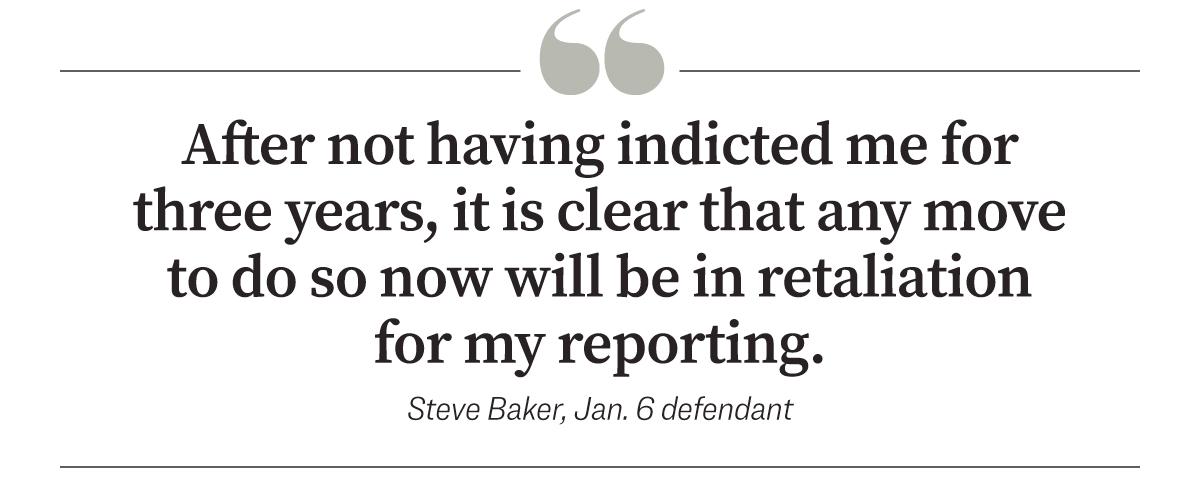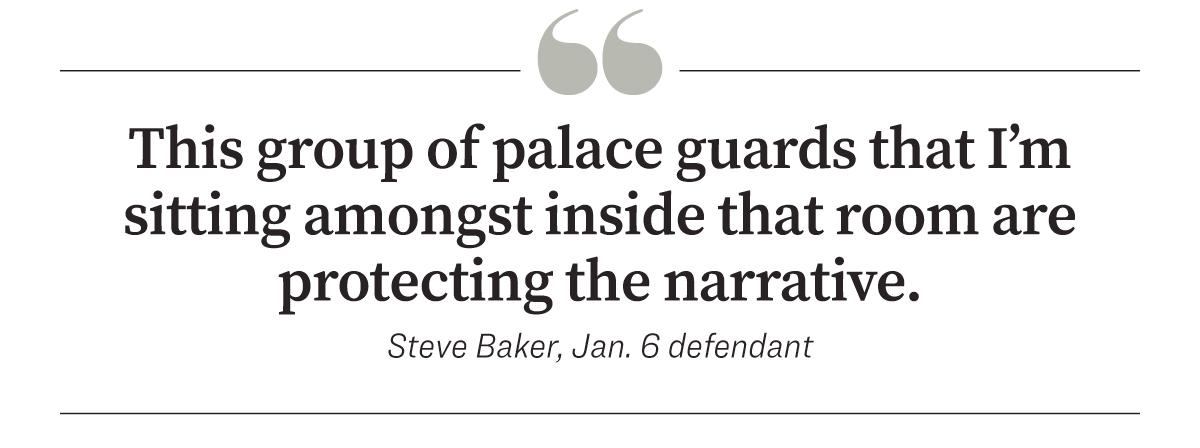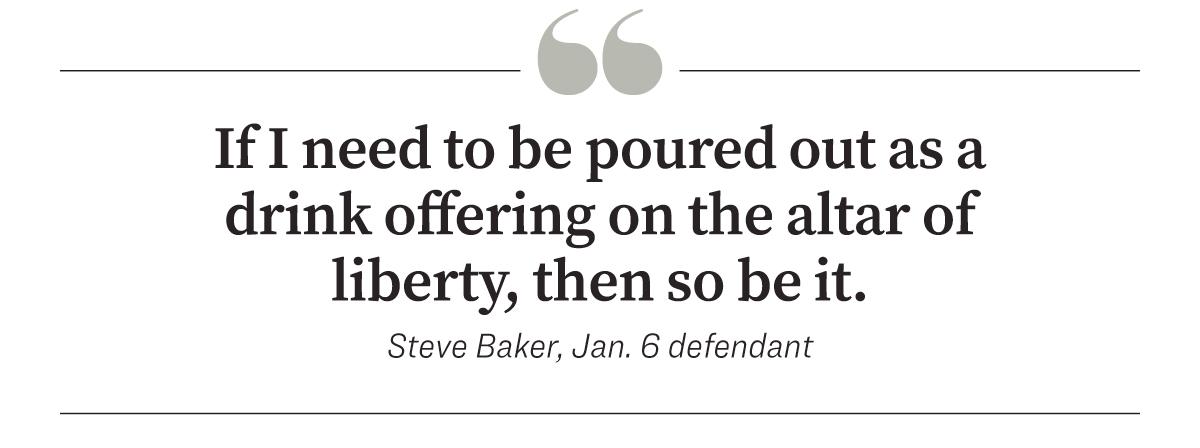Steve Baker, who captured dramatic video on Jan. 6, is charged with four federal misdemeanors. Just who qualifies as a journalist on Jan. 6—and who decides?
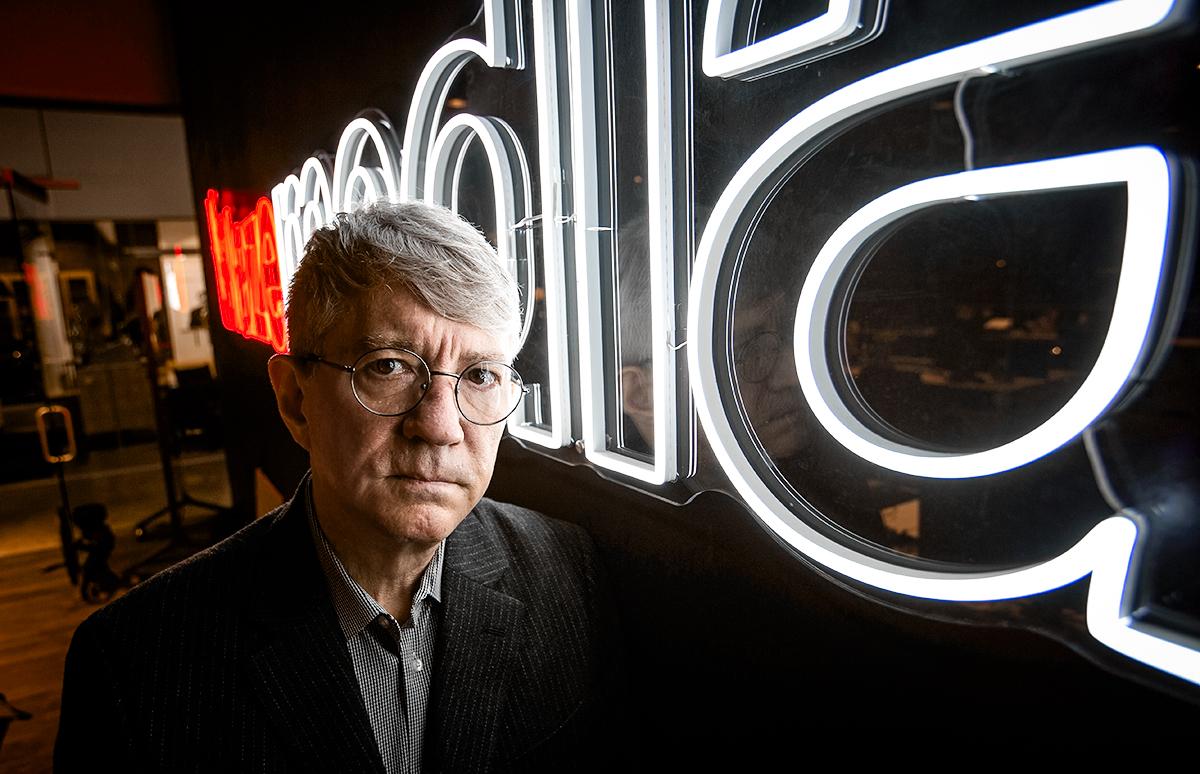
Politics and journalism have had a nagging way of becoming intertwined during Steve Baker’s 45 years of adult life.
As an idealistic twenty-something in the early 1980s, he wanted to run for mayor of his hometown—Shreveport, Louisiana—a place with a storied history of political and judicial corruption.
Mr. Baker thought he could help clean up the “terribly corrupt, almost mafioso-run government,” as he put it. So he sought advice from Kevin Doyle, the city hall reporter for The Times, Shreveport’s daily newspaper.
“No, no, no, no,” Mr. Doyle told him emphatically. “You do not want to do that.”
“Why not?” Mr. Baker asked.
“They will eat you alive,” came the reply.
Mr. Doyle’s admonition made an impression. “He actually talked me out of it,” Mr. Baker said in an interview with The Epoch Times.
Some 42 years later, Mr. Baker finds himself at the center of a swirling storm, buffeted by the blustery winds of Washington politics and an often-partisan debate on just who was a journalist on Jan. 6.
On March 1, Mr. Baker surrendered to the FBI in Dallas on a warrant charging him with four misdemeanor crimes for his presence at the U.S. Capitol on Jan. 6, 2021.
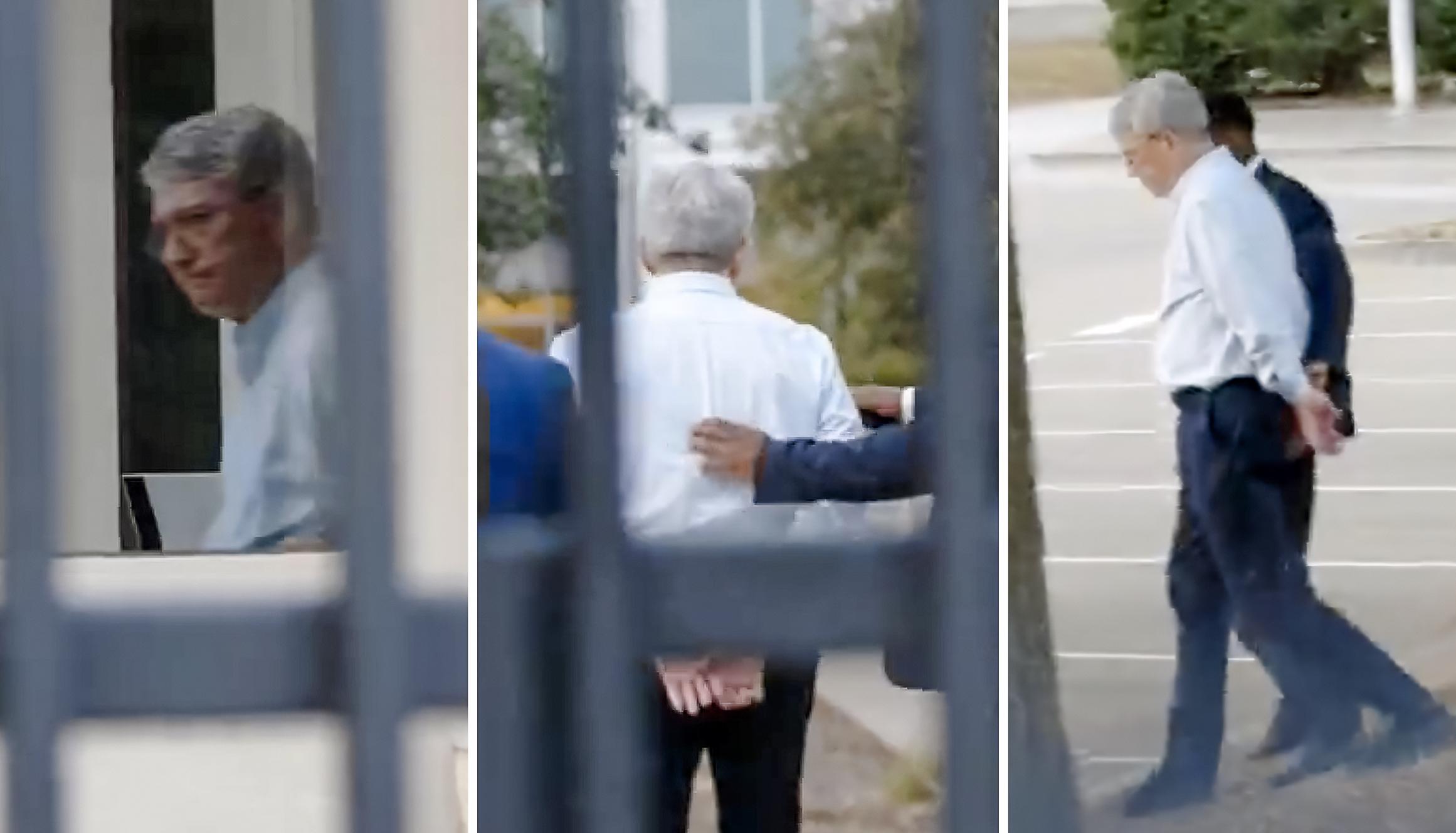
A cell phone video of Mr. Baker in handcuffs being led from the FBI’s guard shack to a waiting car went viral, racking up millions of views that day and 14.6 million views over two weeks.
As he was swept up in the Department of Justice’s historic dragnet, Mr. Baker became at least the ninth independent or “citizen journalist” to face charges over Jan. 6.
Mr. Baker, 63, of Raleigh, North Carolina, said his arrest was really not about his work as an independent journalist on Jan. 6, or a set of alleged trespass-related crimes brought by the Department of Justice (DOJ).
His “sins,” he believes, were a series of articles that portrayed U.S. Capitol Police and the DOJ in a negative light, along with Mr. Baker’s sharp and pointed commentary about Jan. 6-related corruption.
“After not having indicted me for three years, it is clear that any move to do so now will be in retaliation for my reporting,” Mr. Baker wrote in January.
“I will not be intimidated. I will continue to report the findings of my investigation into the evidence being made available to me to review.”
Prominent defense attorneys stood with Mr. Baker at a press conference in Dallas’ infamous Dealey Plaza on Jan. 25 to allege the forthcoming charges against him were more persecution than prosecution.
The painted white “X” on Elm Street where President John F. Kennedy was shot in November 1963 was visible from where Mr. Baker spoke that day. The venue sent a more pointed message than the speeches themselves.
A video compilation of footage from the U.S. Capitol Police security cameras and Steve Baker’s own recording. (U.S. Capitol Police, Steve Baker)
Mr. Baker, a former independent political columnist and now a writer for Blaze Media, is drawing some high-visibility support.
Rep. Jim Jordan (R-Ohio), chairman of the House Judiciary Committee, ripped Mr. Baker’s arrest in a letter to the DOJ and announced his committee has opened an investigation.
Noting that Mr. Baker was put in leg shackles and a belly chain for his appearance in federal court, Mr. Jordan said the conduct “smacks of harassment and selective treatment for a disfavored criminal defendant.”
Even one of the U.S. Marshals who processed Mr. Baker at the federal courthouse expressed sympathy.
“He had the charges in front of him. He looks down at them and he looks up at me,” Mr. Baker recalled. “He said, ‘This is [expletive]. Do you know how many of you guys we’ve had to do this with here in Texas? Just [expletive].’”
The more than three years between his appearance at the U.S. Capitol and his arrest have been a trying time for Mr. Baker, who has lived under the constant threat of prosecution for video he shot that day and articles published since.
He joins a growing list of right-leaning media figures who have been prosecuted for being at the Capitol. Mr. Baker and others on that list captured some of the most iconic and significant video on Jan. 6. But unlike their “mainstream” colleagues, they were arrested for being there.
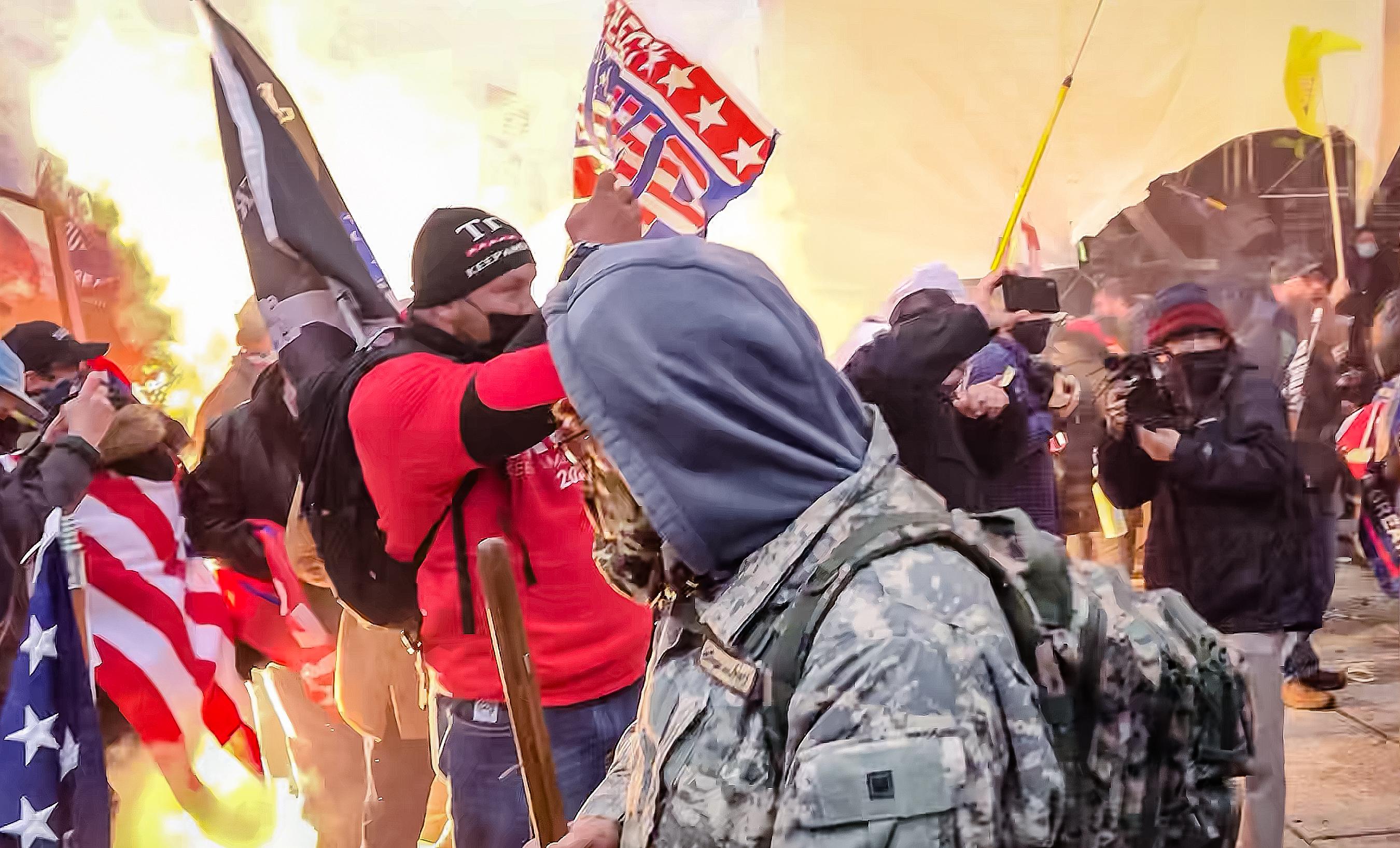
Journalist or Rioter?
An argument raised in some quarters is that Mr. Baker and the other journalists and live-streamers who were arrested are not legitimate journalists. Is that a fair argument? Who decides?
For most of his adult life, Mr. Baker has plied his trade as a professional musician, playing trumpet for the North Carolina band, Bull City Syndicate. For more than a decade, though, he also published a blog of his political writings under the banner of “The Pragmatic Constitutionalist” and before that, “The Pragmatic Libertarian.”
That all changed starting in March 2020, when COVID-19 policies led to the shutdown of his adopted state and most of the country. The pandemic put Mr. Baker on an investigative path.
“The government, like it or not, weaponized me against them the day they took my job away at the end of March 2020,” he said. “Two weeks to flatten the curve became too much, and then that turned into two years. I was effectively not allowed to work and earn an income for 15 months.”
Mr. Baker developed a significant following as he wrote about the pandemic, the liberty-crushing response of government bureaucrats and the rollout of the vaccine mandates. By the time Jan. 6 came around, he had nearly 40,000 followers on Facebook and a growing cadre of subscribers on Locals.
He spent the year prior to Jan. 6 traveling the country, meeting with groups of his paying subscribers to discuss the pandemic and current events. It was a practice he continued in 2021.
As 2020 drew to a close, Mr. Baker told his readers he would attend Jan. 6 events in Washington.
“Not because I think a crowd of any size is going to force government into a real investigation of the election results,” he wrote, “but because the ‘powers that be’ on all sides of the political equation need to see We the People in force, letting them know that we are watching.”
Mr. Baker said his plans included capturing events and getting reactions from attendees.
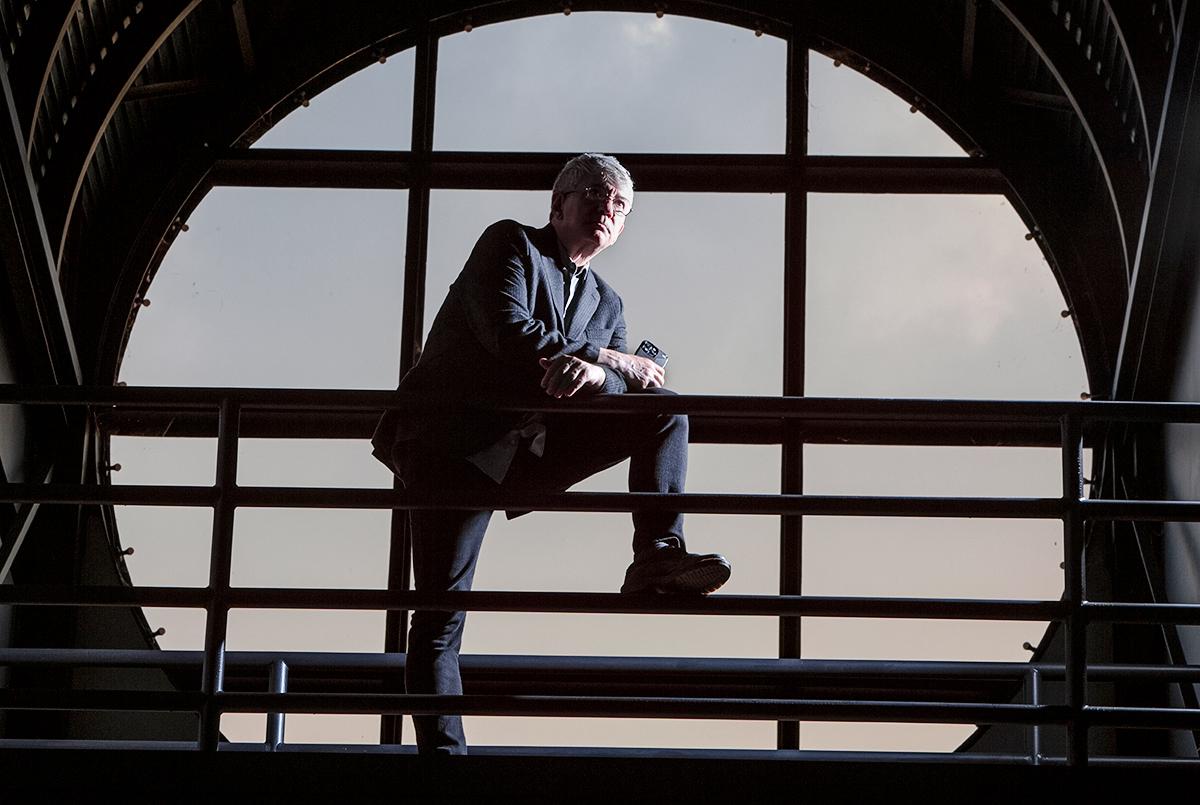
“I’m also hoping to document on video anything ‘special’ that might happen,” he told his Locals subscribers, “and perhaps get a few interviews from a variety of voices.”
Mr. Baker did not approach his trip as any kind of fan of former President Donald Trump, whom he didn’t support in 2016 but voted for in 2020.
“Trump is still promoting the ‘wild’ protest rally in D.C. on the 6th,” Mr. Baker wrote on social media on Dec. 28, 2020. ‘Details to come,’ he says. True believers persist in presenting ‘evidence’ of troop and hardware movements to support the coming tidal wave of ‘conclusive proof’ that massive election fraud and ‘John Roberts flew on Epstein’s plane’ are going to justify a military coup.”
When Mr. Baker and a friend got to Washington, they listened to President Trump’s speech from near the Ellipse, but concluded the massive rally was the “nothing burger of all time” and left early for the Capitol.
As they approached the Capitol’s west side, Mr. Baker saw a large group of police officers in fluorescent jackets flowing down the steps toward the plaza. “That’s where we’re going,” he said.
“I turned on my camera on the Lower West Terrace at exactly 1:19 p.m. The first thing I captured were people on both sides of the line receiving first aid,” he said. “For the next hour or so I was filming the melee. That’s why they call it the front. That was the battle happening right there.”
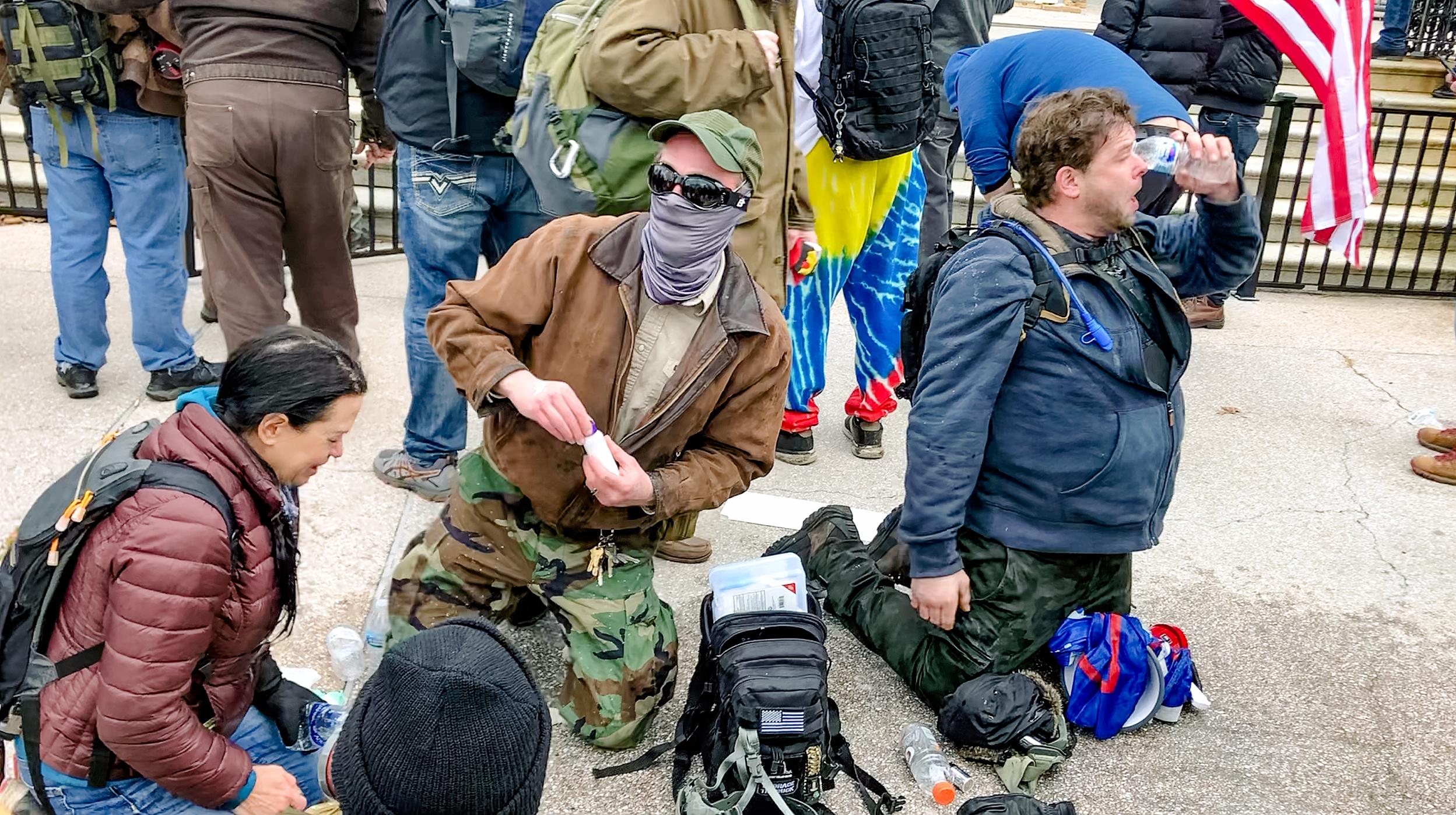
Iconic Video Footage
Mr. Baker turned on his camera just minutes after President Trump finished his speech at the Ellipse.
“The very first thing that really, really captured my attention was I saw fully credentialed mainstream press videographers on that battle line, wearing full riot gear, including gas masks,” he said. “They were already tipped off where to post up.”
Mr. Baker went inside the Capitol through the Senate Wing Doors just after 2:20 p.m. Security video shows him with camera up, filming the whole way. An enthusiastic protester was just inside the entry, offering high-fives to the streaming crowd. Mr. Baker turned slightly left in the doorway to avoid the man’s hand, then took a hard right and walked inside.
Mr. Baker walked through the same set of doors used by reporters and photographers from the New York Times and the Los Angeles Times. A writer for The New Yorker climbed through an adjacent broken window. Mr. Baker is the only one among them who was arrested and charged.
“None of those who worked for major media—left wing sources—have been prosecuted,” he said. “But you can’t say the same on the other side of the ledger.”
Mr. Baker’s video, combined with Capitol Police security video, tells the story of what he observed inside the Capitol.
In each location, CCTV shows Mr. Baker with his camera raised in his right hand filming the action, or with his phone out taking notes. A tripod stuck out from his backpack in the event he did location interviews.
Scenes included protesters streaming through Statuary Hall, an angry crowd confronting police in the Statuary Hall Connector, a swelling crowd rumbling through the Crypt, and panicked police officers pointing weapons at Mr. Baker and others inside the south entrance.
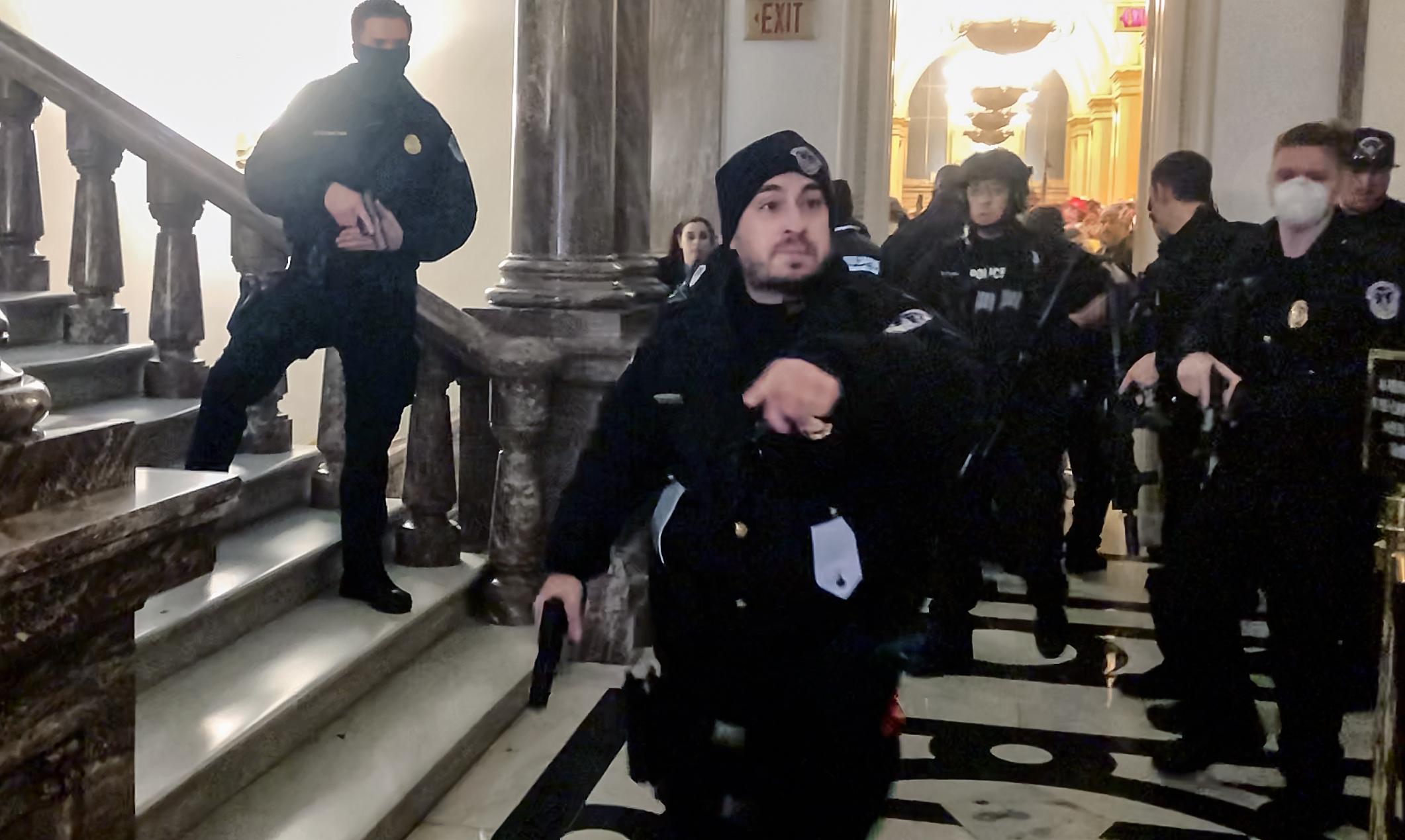
“Are you going to use that on us?” Mr. Baker asked one Capitol Police officer who charged at the group. “None of us have a gun. We’ve got cameras.”
As the officer explained why the dozen or so law-enforcement officials in the lobby had weapons ready, Mr. Baker intoned dryly, “The only shots fired have been fired by you guys.” While filming on the west plaza, Mr. Baker said he was struck in the leg by a police projectile.
Mr. Baker made his way outside the south entrance just as paramedics rushed a mortally wounded Ashli Babbitt down the ramp. His camera followed the gurney and captured the haunting look of Ms. Babbitt’s expression as rescuers tried in vain to restart her heart. It was the last the world saw of the 35-year-old Air Force veteran after she was shot point-blank by Capitol Police Lt. Michael Byrd.
A distant security camera showed Mr. Baker with his camera extended, following the gurney toward a waiting D.C. rescue squad.
By the time Mr. Baker returned to North Carolina, the FBI had begun arresting the first of the now more than 1,360 protesters for alleged crimes. Not knowing what to expect next, Mr. Baker said he felt an urgent need to pen an article about all he had observed at the Capitol.
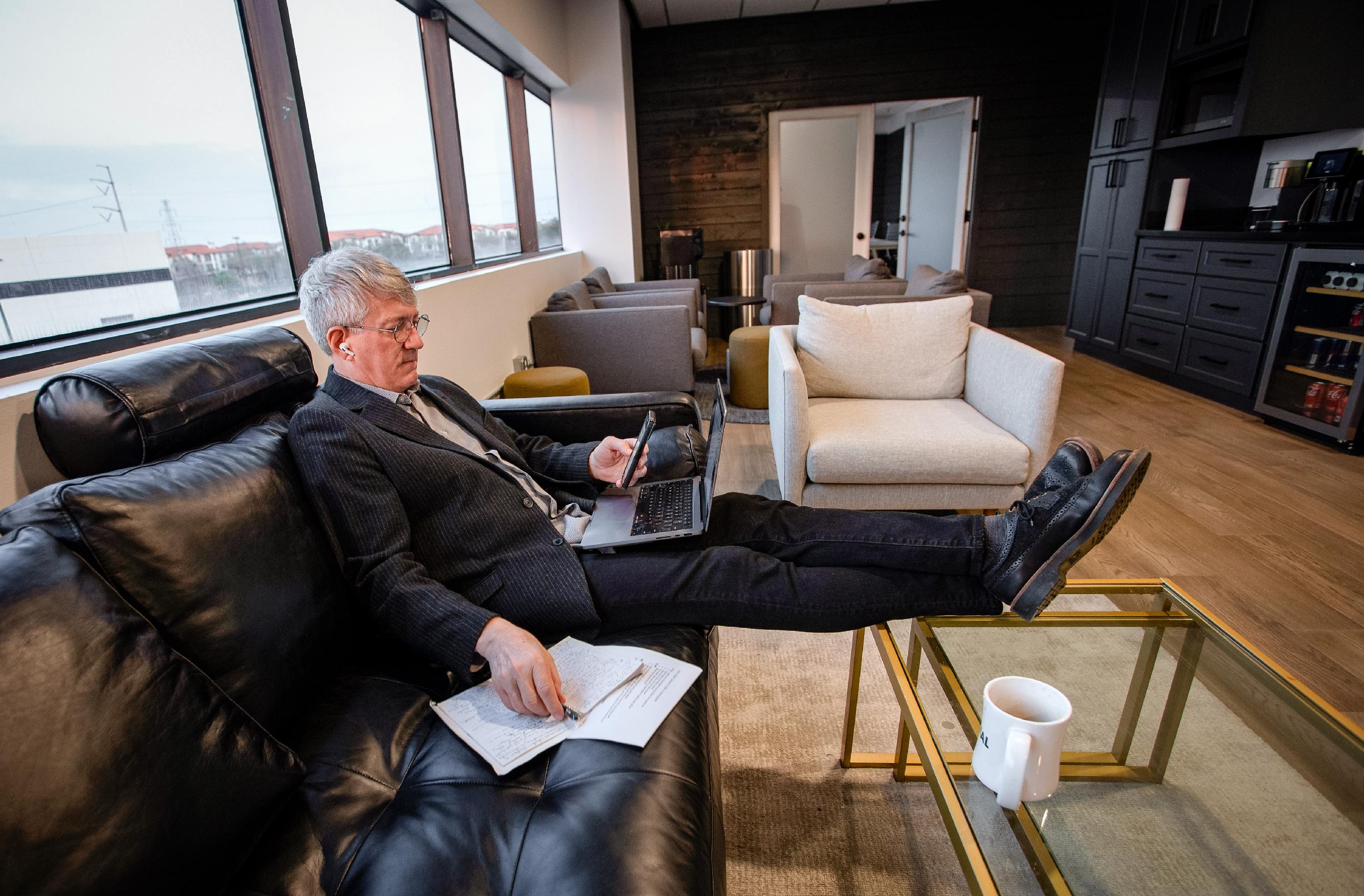
“I didn’t know if the dragnet was going to be dropped on me the next day,” he said. “So I literally went to a secure location. I stayed for the next several days with a friend of mine who is retired special forces.”
That visit did more than just keep him out of the reach of law enforcement. It began to reveal and clarify what Mr. Baker captured on video.
“I did five days of frame-by-frame video analysis of my own videos,” he said. “I spent the next couple of days writing my story. My first story was 9,500 words about what I saw on January 6.
“I had not only the retired special ops guy that I was staying with but another special ops guy who also was looking at my videos with me,” Mr. Baker said. “Both of them were pointing out to me the, let’s just say, ‘anomalous’ characters in the crowd.
“They were showing me, ‘Okay, this guy’s doing this because it’s his job. This gal is doing this. This is her job.’ They had seen this before, because they participated in operations overseas—color revolution operations—executed by our own government.”
Mr. Baker’s magnum opus “What I saw on January 6th in Washington D.C.,” went live on Jan. 13, 2021. It was quickly compared by readers to another lengthy article published by J. Michael Waller, a senior analyst at the Center for Security Policy in Washington.
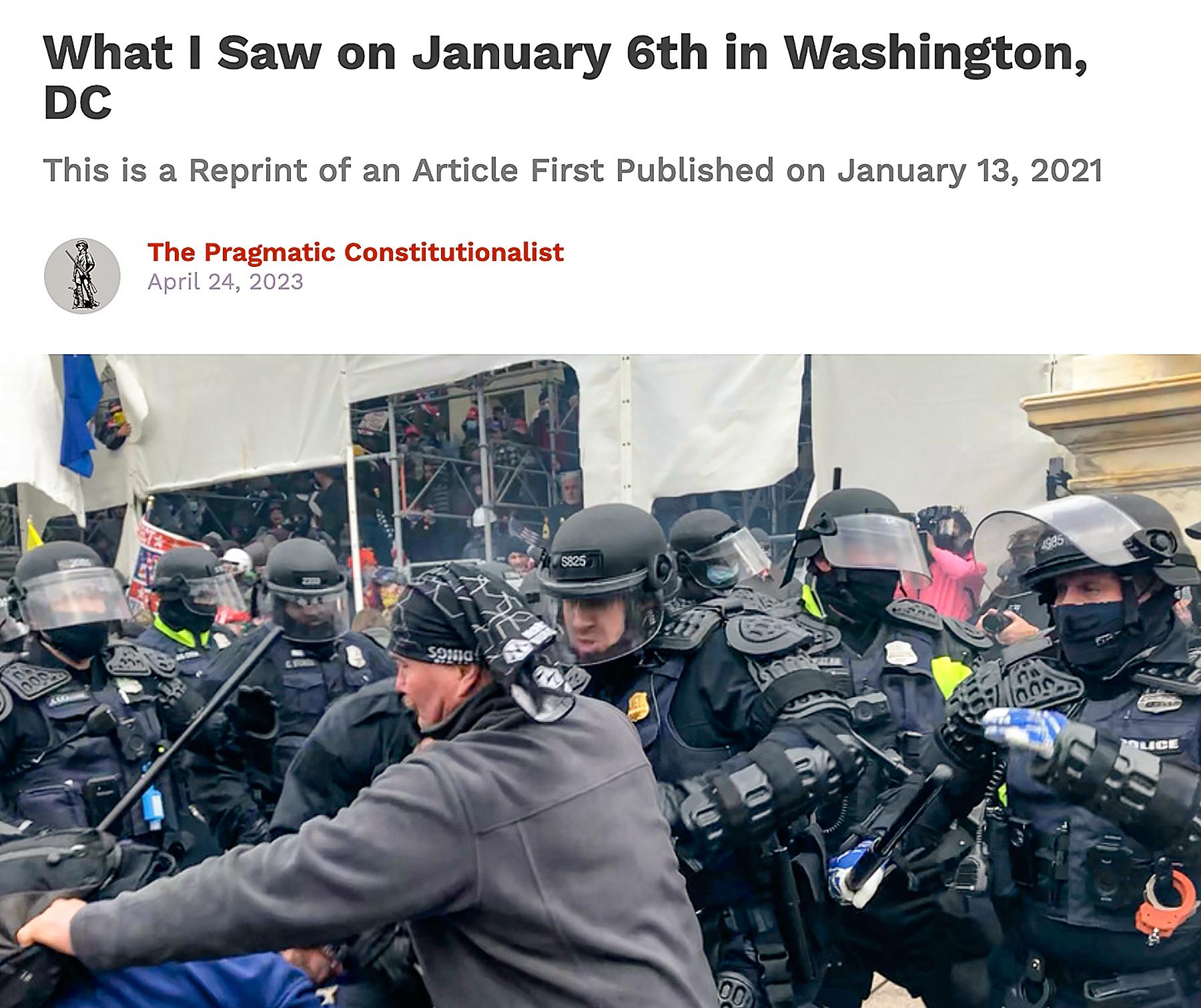
Mr. Waller’s review started thusly: “The deadly riot at the U.S. Capitol bore the markings of an organized operation planned well in advance of the January 6 joint session of Congress.”
Mr. Baker said he and Mr. Waller didn’t know each other before Jan. 6 but have since had the opportunity to compare notes and observations. “We’ve been fast friends ever since,” he said.
After returning home from his writing sabbatical, Mr. Baker was faced with a slew of requests for his Jan. 6 video. He licensed clips to the New York Times and HBO, then hired Storyful to manage licensing and distribution of the video.
FBI Comes Calling
The first hint of Jan. 6 trouble came in July 2021 when North Carolina-based FBI agents contacted Mr. Baker seeking to interview him about Jan. 6. But before he could meet with the two agents, the session was delayed.
“We clearly have it on the record,” he said, “when my first FBI interview was scheduled, they got a call from D.C. that said, ‘You cannot interview him because of his status—or alleged as the case may be—as a journalist without a written letter of permission from the attorney general.”
The interview was reset for the fall of 2021. Mr. Baker learned that prosecutors were looking at charging him with interstate racketeering because of the money he made licensing his video to other media. The implication was that somehow he knew illegal acts would be committed on Jan. 6 and he planned to profit from them.
FBI special agents Craig Noyes and Gerrit Doss questioned Mr. Baker twice. The first meeting was recorded at Mr. Baker’s insistence. As part of a proffer agreement, the second meeting was not supposed to be recorded.
“Even after I sat down at the table across from the FBI agent with my attorney, I challenged them on that yet again,” Mr. Baker said. “It actually got very heated, to the point where my attorney turned around and looked at me and said, ‘Have you changed your mind and you’ve decided to not do anything unless you are allowed to record it?’”
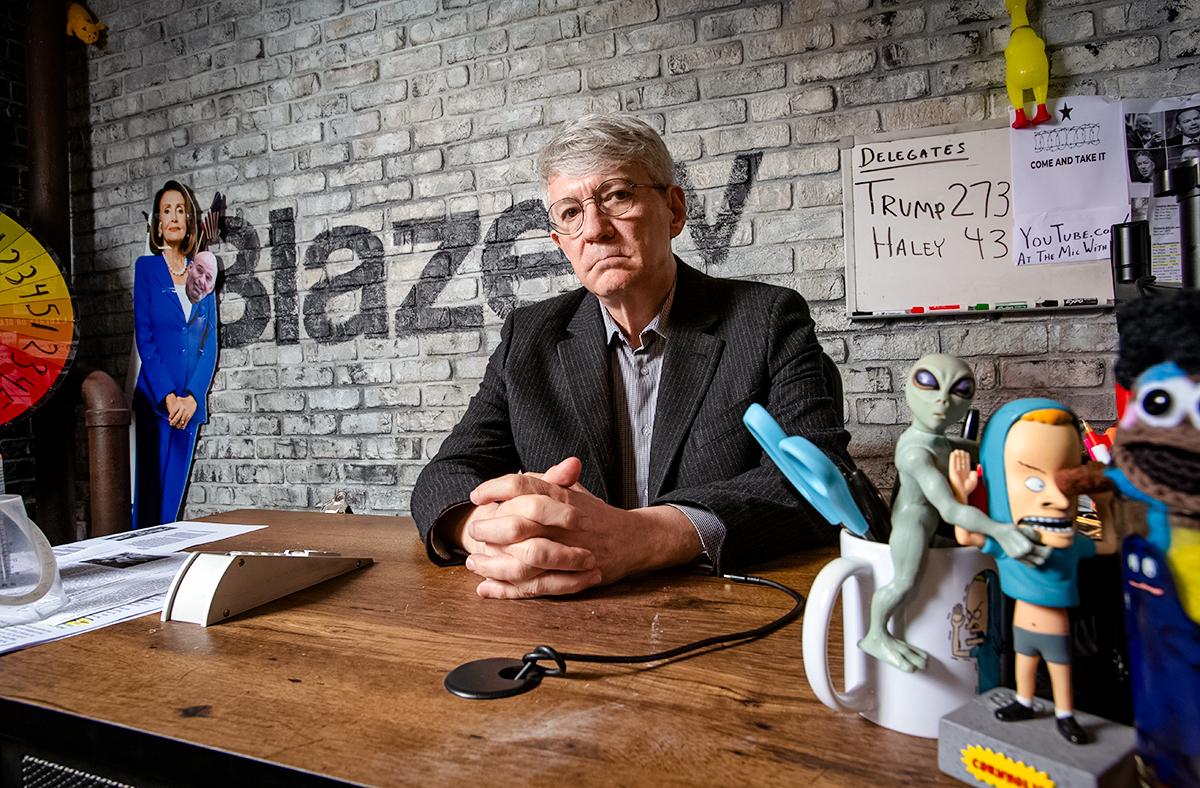
Another important detail was contained in the Department of Justice proffer: “Nothing that I said in that interview could be used against me in a court of law,” Mr. Baker said.
In November 2021, Mr. Baker’s attorney received word that he would be charged in federal court within the week. His response was a media blitz calling attention to the DOJ’s plans to jail a journalist over Jan. 6. News releases were sent to hundreds of media outlets.
“I was interviewed by French television, British television, Russian television, and Newsmax,” Mr. Baker recalled.
Toward the end of the week, Mr. Baker took a call from his new attorney, Brad Geyer. “‘I think you’ve finally built a moat around yourself, establishing your legitimacy as a reporter,’” Mr. Baker recalled Geyer telling him. “‘I think they can’t touch you now.’”
The high-stakes ploy did not win Mr. Baker any fans at the DOJ. That was to become a theme of his life and his work over the next 18 months.
In February 2021, Mr. Baker wrote about elements of a secret U.S. Army special forces unit from Fort Belvoir, Va., that were embedded at the U.S. Capitol on Jan. 6.
It was a bombshell revelation that made little media splash until 10 months later, when Newsweek reported on commandos at the Capitol on Jan. 6 with “shoot-to-kill” authority. What isn’t clear to this day is what potential threat led to any special ops boots being on the ground, regardless of who ordered them there.
Mr. Baker said his theory is that these elite commandos were embedded in the crowd in case protesters arrived at the Capitol heavily armed—something that despite leftward propaganda claims, never occurred. The feared assault rifles turned out to be sticks, flagpoles, and bear spray, which Mr. Baker said “do not an insurrection make.”
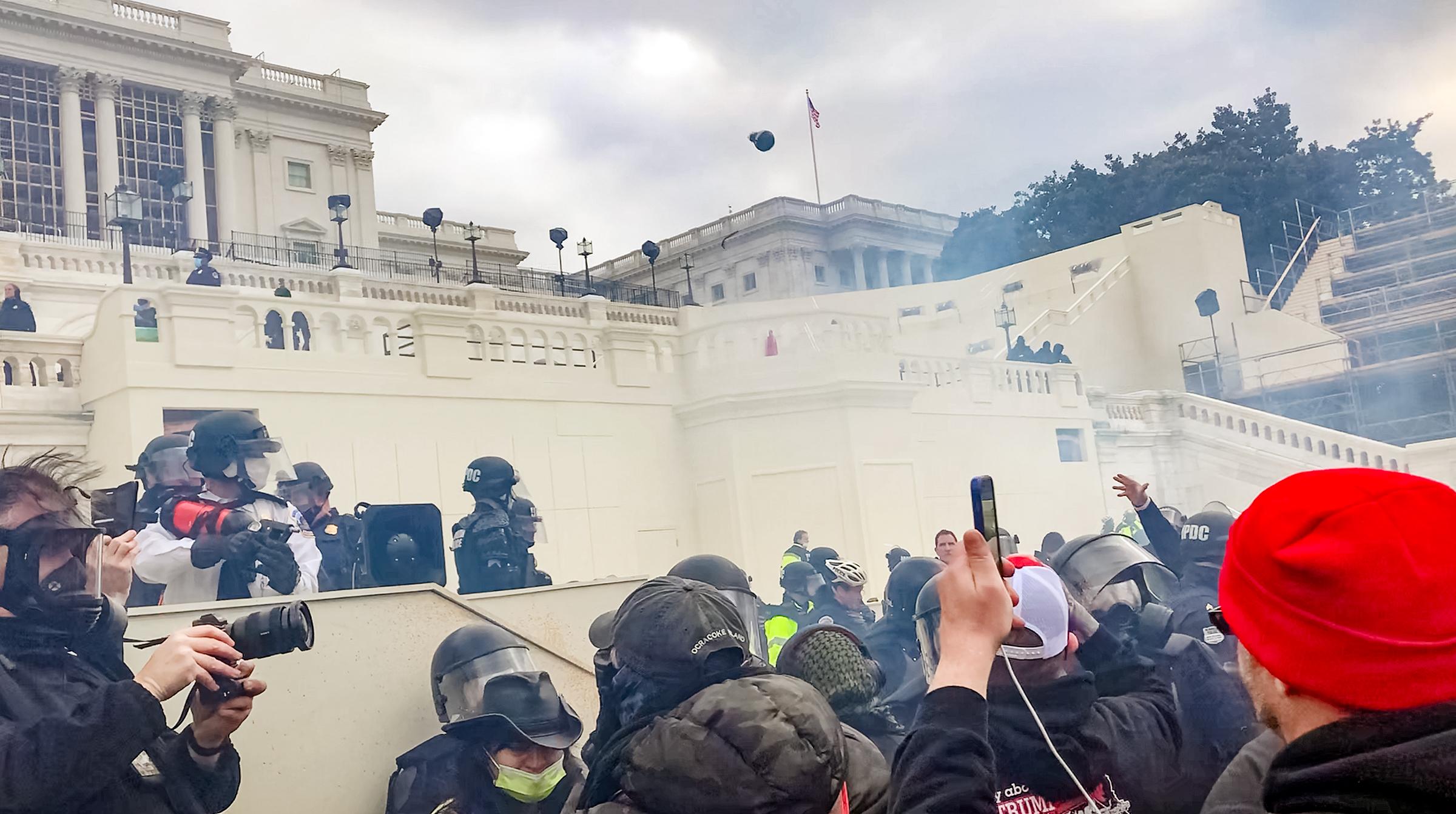
Oath Keepers Defense
Mr. Baker started to get more widely noticed in the fall of 2022, when he began a unique role covering the trial of Oath Keepers founder Elmer Stewart Rhodes III, three other Oath Keepers, and one associate. Given his relationship with Mr. Geyer, who represented Oath Keeper Kenneth Harrelson, Mr. Baker got a back-room view of the defense team and wrote extensively about the trial for more than nine weeks.
As the long trial wore on, Mr. Baker’s daily video summaries and tweet-storms on Twitter drew a growing audience. In addition to his insider’s view, Mr. Baker reported on the machinations of the corporate journalists working in the courthouse press room.
On several occasions Mr. Baker noticed a group of corporate media reporters in a huddle around one of their computers during trial testimony in the nearby courtroom of U.S. District Judge Amit Mehta. Listening from across the media room, Mr. Baker theorized he was witnessing media collusion at work. Stories published later in the day or the following morning bore that out with similar headlines and details in many stories.
“It was the single most stark moment of realization that I had,” he said. “This group of palace guards that I’m sitting amongst inside that room are protecting the narrative.”
One day a well-known broadcast journalist introduced himself with a back-of-the-hand slap.
“‘I’ve been following your stuff. I’ve been following your Twitter, watched some of your videos and read some of your articles,’“ the reporter said, according to Mr. Baker. ”‘How come you haven’t been indicted yet?’”
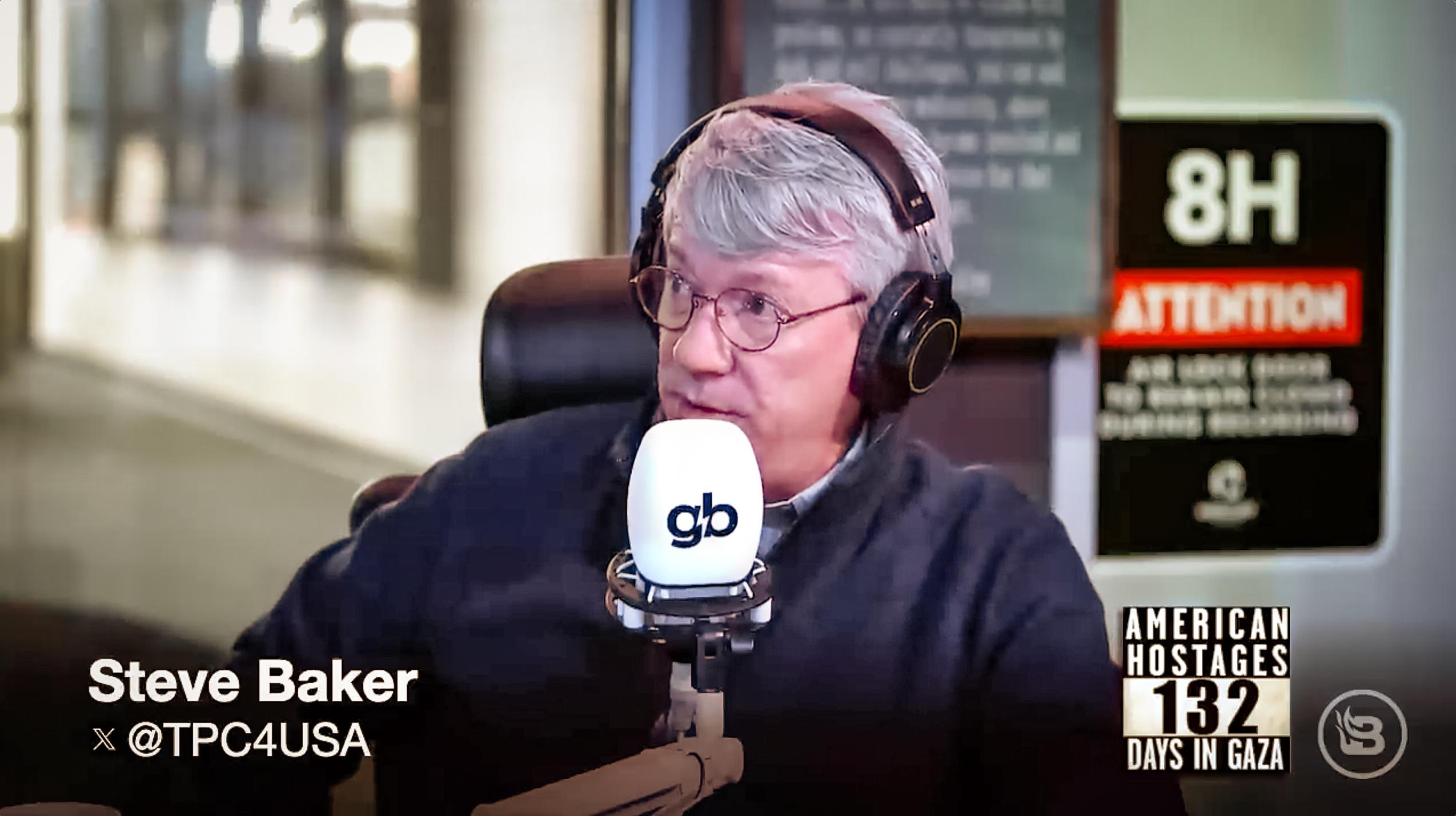
With that, Mr. Baker said he knew he no longer flew under the radar. But he continued to call out major-media omissions in coverage.
A prime example involved key prosecution testimony from Abdullah Rasheed, an alleged West Virginia Oath Keeper who recorded an online meeting in November 2020 that he thought involved Oath Keepers planning for war against the government.
During cross-examination, Mr. Rasheed admitted that he had been convicted of the aggravated sexual assault of a child. He told defense attorneys he used a dozen different names over the span of 20 years. Mr. Baker described Mr. Rasheed’s testimony as a train wreck for the prosecution. He said only Josh Gerstein of Politico published an accurate and complete account of Mr. Rasheed’s testimony. No other major media mentioned the admissions Mr. Rasheed made on cross-examination, Mr. Baker said.
“I think the others were so frightened to send stories to their editors that the Department of Justice put a convicted child molester on the stand,” Mr. Baker said.
“When I write the book on the Oath Keepers trial, this is going to be the key moment, when the prosecution called Abdullah Rasheed to the stand early in the trial.”
Music and Investigations
Mr. Baker was no stranger to investigative work or high-stakes assignments in dangerous territory.
As a young man, he often did gumshoe work for his father, George O. Baker, a well-known private detective in Shreveport. When on breaks from his tours as a professional musician, Mr. Baker picked up surveillance assignments.
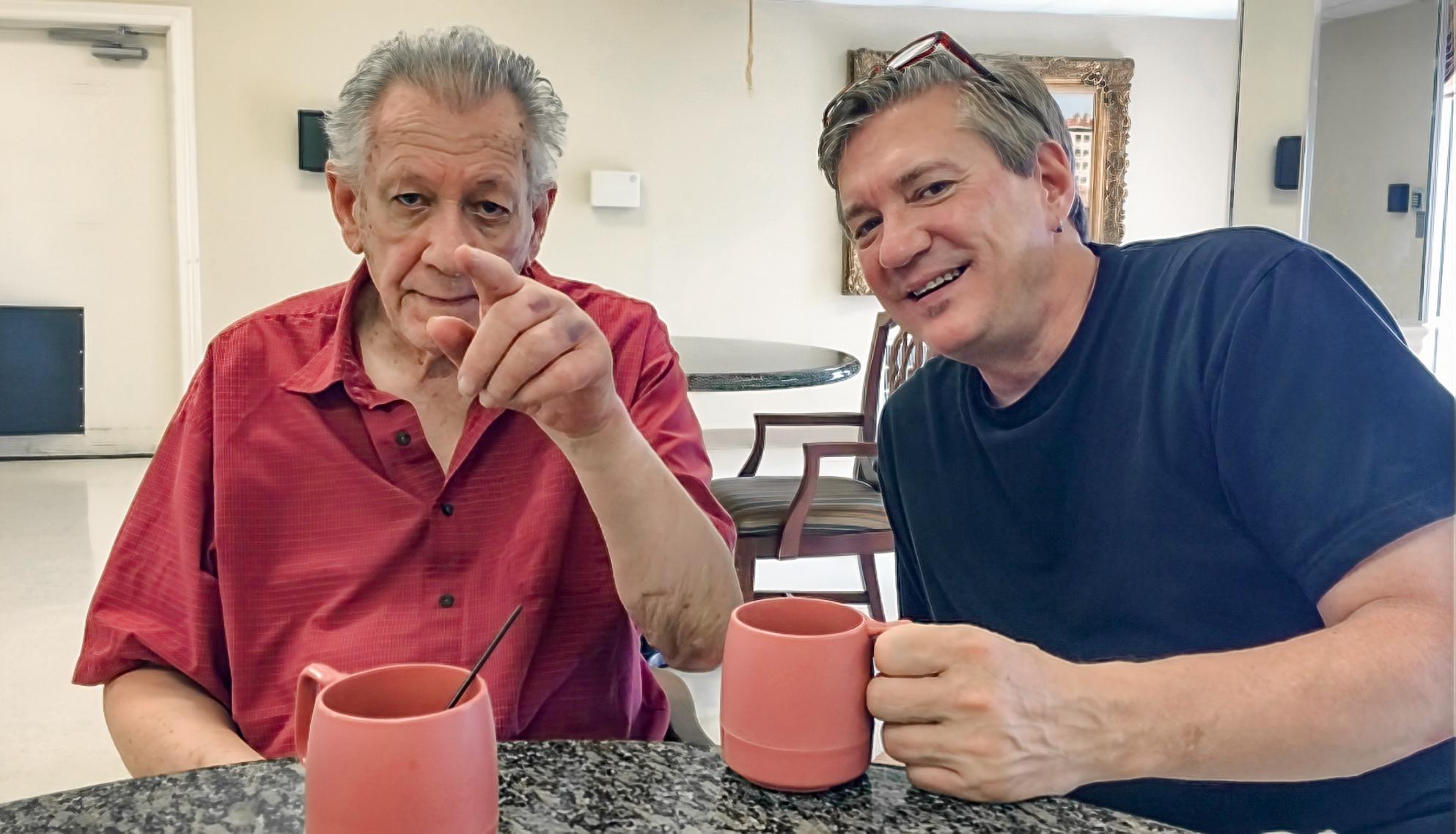
“He would give me the crap, domestic cases like divorce and adultery,” Mr. Baker said. “I would go out and I would investigate those or sit in front of somebody’s house all night long. An old school kind of thing that the FBI used to do. I would do surveillance throughout the night while I was young enough to stay up all night.”
While Mr. Baker didn’t have a close relationship with his father, he was amazed at his “profiler’s gift” in missing-person investigations that the FBI declared cold cases.
“He would go lock himself in the office, and whether it took him three hours or three days, when he came out of that office, he knew where they were,” Mr. Baker said.
His father had a dual career. His other vocation was as a preacher. It wasn’t unusual for him to plunk his handgun on the podium during sermons.
“He was an old school, southern Louisiana Pentecostal,” Mr. Baker said. “Fire and brimstone, swinging from the chandelier, rolling under the pews Pentecostal.”
In his early twenties, Mr. Baker got the chance to tour with a band throughout Europe and into the former Soviet Union. The Christian rock/pop band, Living Sound, hired Mr. Baker in January 1980 without an audition based on one band member’s recommendation. “Their trumpet player ran off with the soprano and got married,” he said. The band had an airline ticket waiting in Shreveport a few days later.
“It was the second Wednesday of January if I remember correctly,” Mr. Baker said. “I landed in San Diego about nine o’clock and the tour bus picked me up and took me straight to an all-night rehearsal. By Friday, I was standing on stage with them performing.”
Within two weeks, Mr. Baker was in a San Francisco studio, rehearsing what would become the theme song for the 1980 Summer Olympics in Moscow that the United States boycotted.
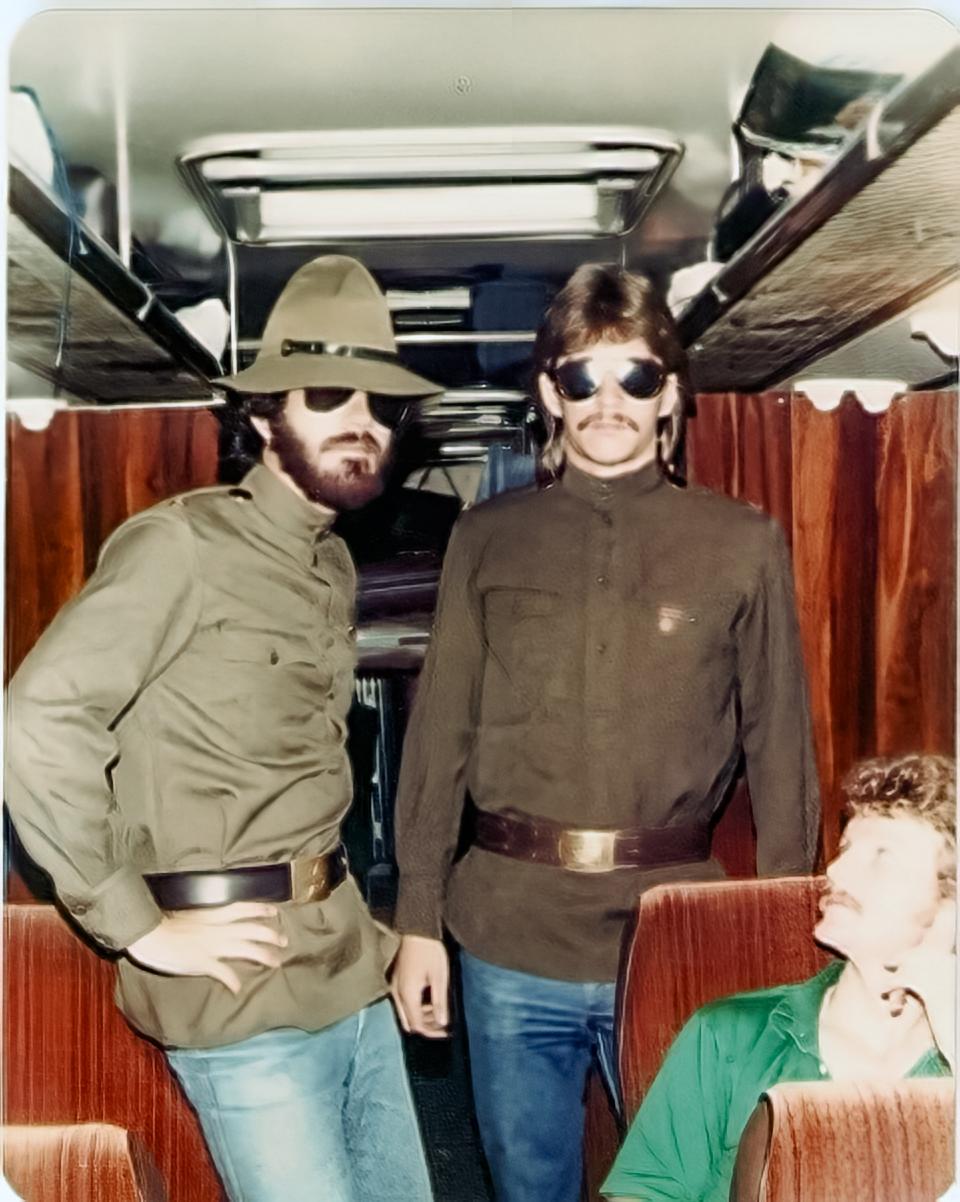
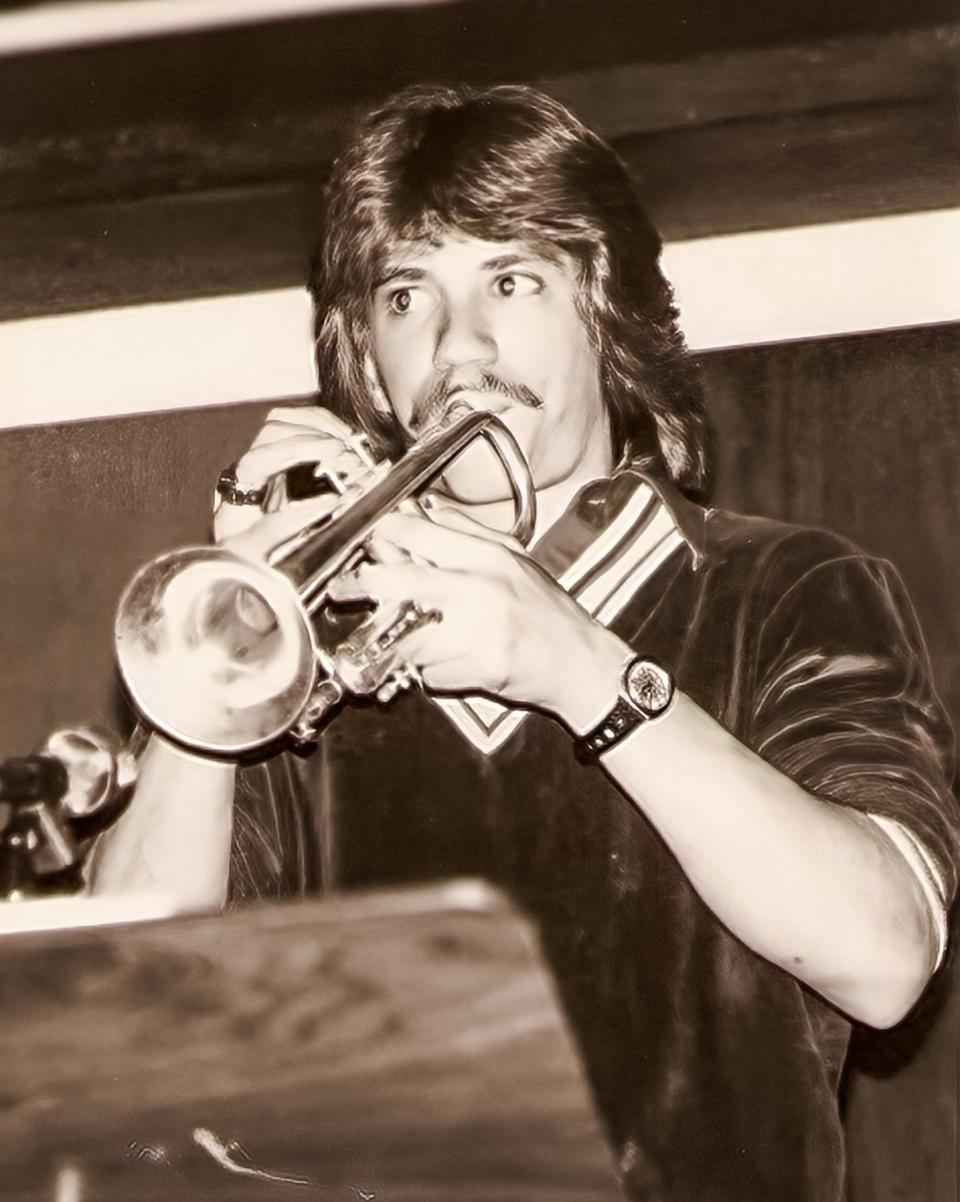
A couple months before Mr. Baker joined Living Sound, the band was in Moscow, performing a secret concert with a couple of well-known Russian bands. A special guest that night, Alexandra Pakhmutova, was a member of the Supreme Soviet—someone so influential she had her own signature brand of vodka.
She was also a classical-music composer said to be a favorite of Soviet leader Leonid Brezhnev. She had composed the theme song for the 1980 Olympic games, the name of which translated as, “We can’t live without each other.”
“She loved the idea of having a non-Soviet or Russian band, something more international,” Mr. Baker said. “We were made up of Americans, Canadians, and a Swede. She loved that idea, so we did the theme song.”
Living Sound toured across the USSR in July 1981. When the group arrived in Moscow, the weather was so hot that sponsors couldn’t find a theater for the performances.
Yuri Filinov, the editor of Komsomolskaya Pravda, hatched a plan to have Living Sound perform in the air-conditioned theater sound stage at Soviet Central Television in Moscow. Mr. Baker said band members didn’t believe the concert would really take place, until they stood on stage on July 23, staring out into 500 seats occupied by the “elite of Moscow.”
“The room was completely full. We did the show. It went great,” Mr. Baker said. “We left and you know, we’re obviously pumped. We played the song that we had recorded a demo to a year and a half earlier. We’re excited about all of that. We went away and finished our tour.”
The group didn’t learn until much later that the concert was broadcast “at least twice” on Soviet television. Mr. Baker tried in vain to locate a video or recording of the concert after the fall of the Soviet Union.
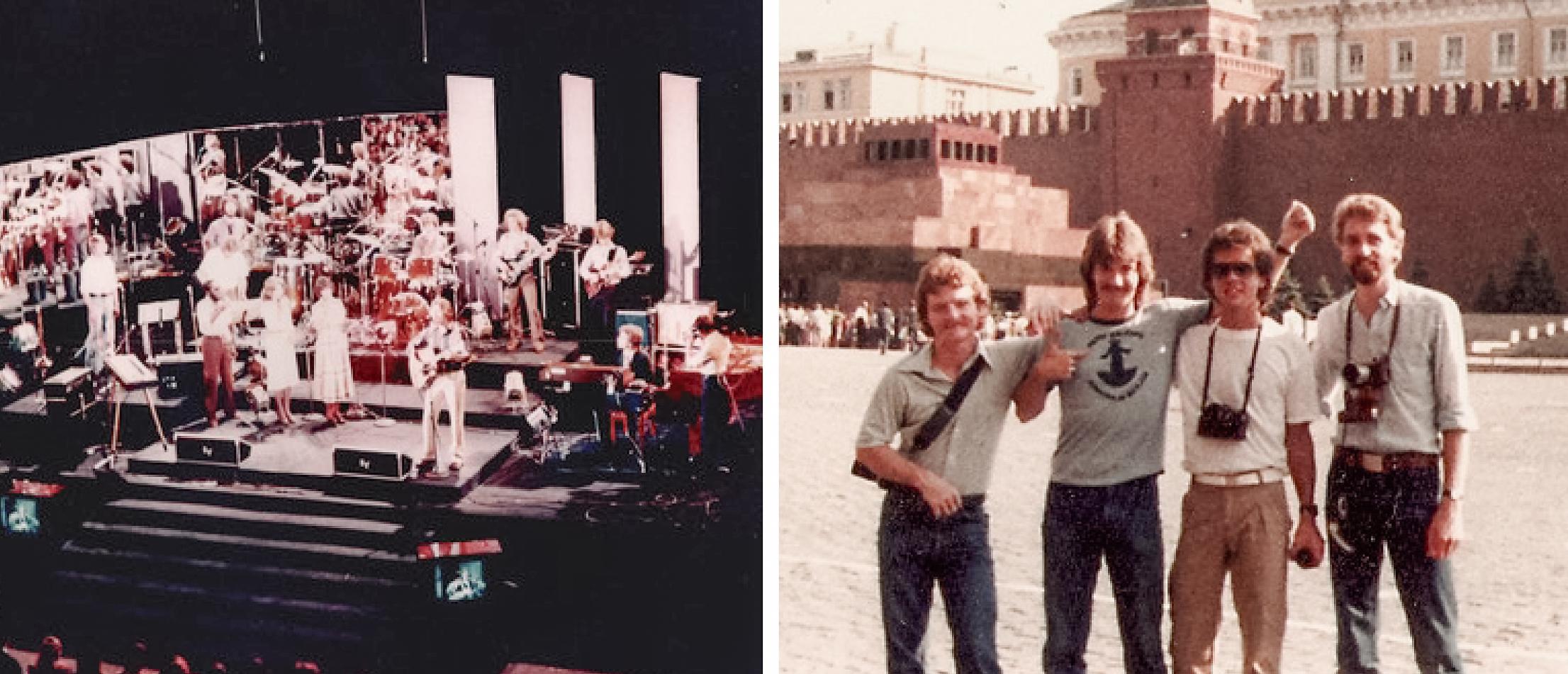
The Price of Liberty
With the threat of prosecution seemingly a distant memory, Mr. Baker turned his efforts in earnest to uncovering details of Jan. 6. He published a three-part series on the U.S. Capitol Police and his belief the rank-and-file were “sacrificial pawns” set up to fail that day. The series resulted in current and former officers contacting Mr. Baker with tips for other angles to investigate.
Mr. Baker harbored lingering suspicions from the Oath Keepers trial about testimony given by two Capitol Police officials about an alleged confrontation between police and a group of Oath Keepers. The confrontation story was contradicted by Oath Keepers testimony that members had protected and shielded USCP Officer Harry Dunn from angry protesters.
After limited access had been granted to tens of thousands of hours of Capitol Police security video by House Speaker Kevin McCarthy (R-Calif.), Mr. Baker spent days in a special video room, sifting through footage from more than 1,000 cameras outside and inside the Capitol.
During one particularly fruitful session, Mr. Baker previewed video of Mr. Dunn in various locations inside the Capitol, along with the location of Special Agent David Lazarus, a USCP dignitary protection officer.
Mr. Baker made several follow-up trips, which led to a special report published by his new employer, Blaze Media, claiming trial testimony by Mr. Dunn and Mr. Lazarus couldn’t be true. The stories by each man contradicted the other’s testimony, and CCTV video showed they were not in the same area together.
The Dunn–Lazarus story prompted calls from Oath Keepers defense attorneys to overturn the guilty verdicts made against the men by a D.C. jury.
Mr. Baker received word from a media source and other contacts inside the DOJ throughout 2023 that his reporting was being noticed—and not in a good way.
“The journalist who gave me the information has a very large national audience and would be the kind of person who would have those types of sources,” Mr. Baker said in March 2023. “So I had to take it seriously.”
By Christmas 2023, Mr. Baker was under renewed threat of prosecution. His video from Jan. 6 had been subpoenaed by a grand jury in August 2023 and now the FBI sent word his arrest was imminent.
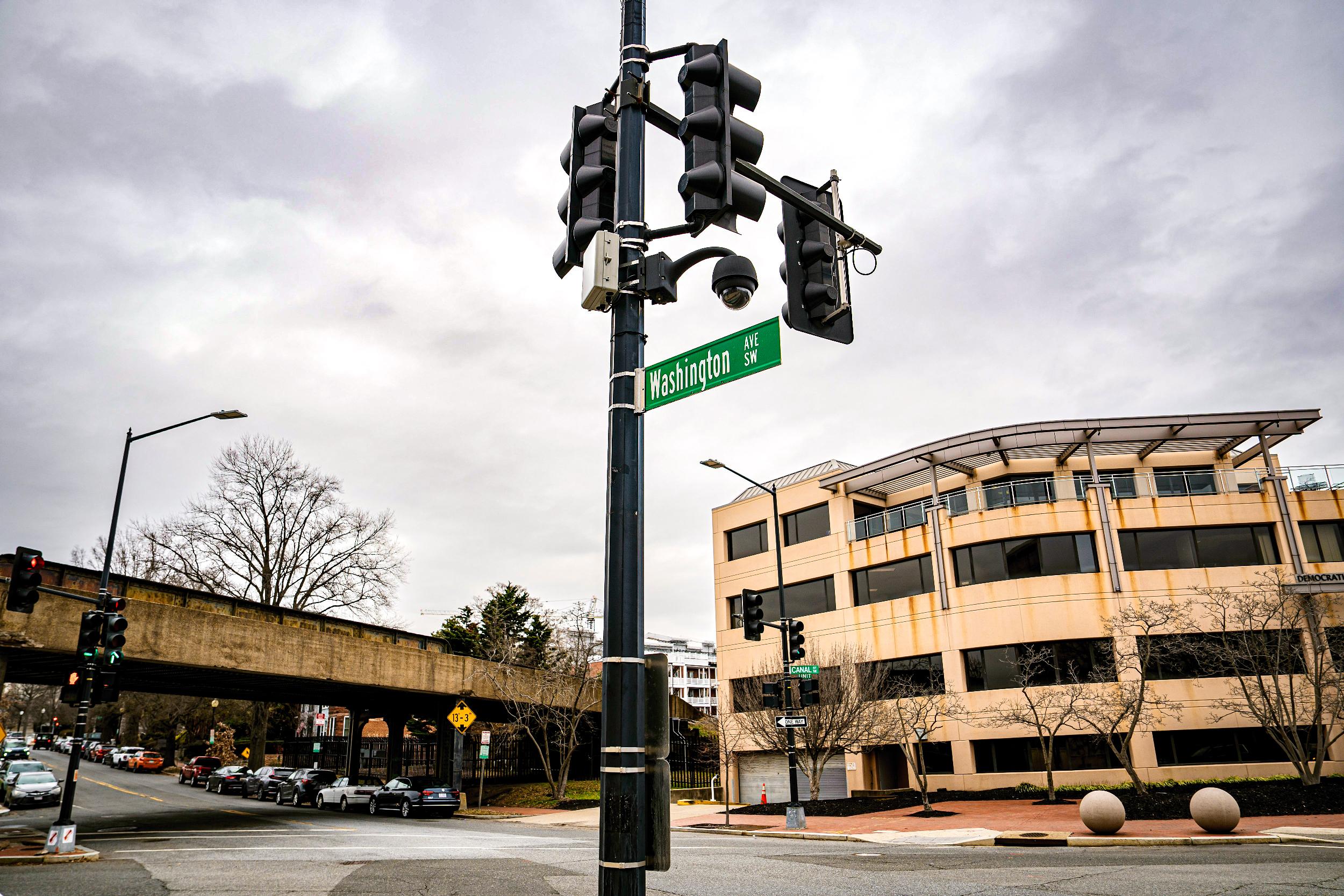
Mr. Baker continued his work unabated, learning new details on the pipe bomb discovered next to the Democratic National Committee building on Jan. 6. In January 2024 he reported that the person who discovered the bomb just after 1 p.m. that day was not a passerby, but a plainclothes Capitol Police officer.
He followed that report with video showing how the Capitol Police bomb squad neutralized the pipe bomb with an unmanned ground vehicle, also known as a bomb robot. He detailed how a key security camera was turned away from the bomb scene.
The Epoch Times confirmed Mr. Baker’s coverage and detailed its own finding that a second and third camera were turned away from the scene as police responded to the DNC pipe bomb.
During a radio appearance on the Glenn Beck program on Jan. 29, U.S. Rep. Barry Loudermilk (R-Ga.) praised Mr. Baker’s pipe bomb reporting and took a dig at the FBI’s lack of success finding the alleged bomber. He said Mr. Baker “has done a tremendous job” and “he has more leads than the FBI did.”
On March 20, Mr. Baker published an exposé alleging felony time-card fraud within U.S. Capitol Police was covered up for a decade. The scofflaws, he wrote, were not fired but eventually promoted.
Mr. Baker was arrested in Dallas on March 1 and charged with four Jan. 6 misdemeanors.
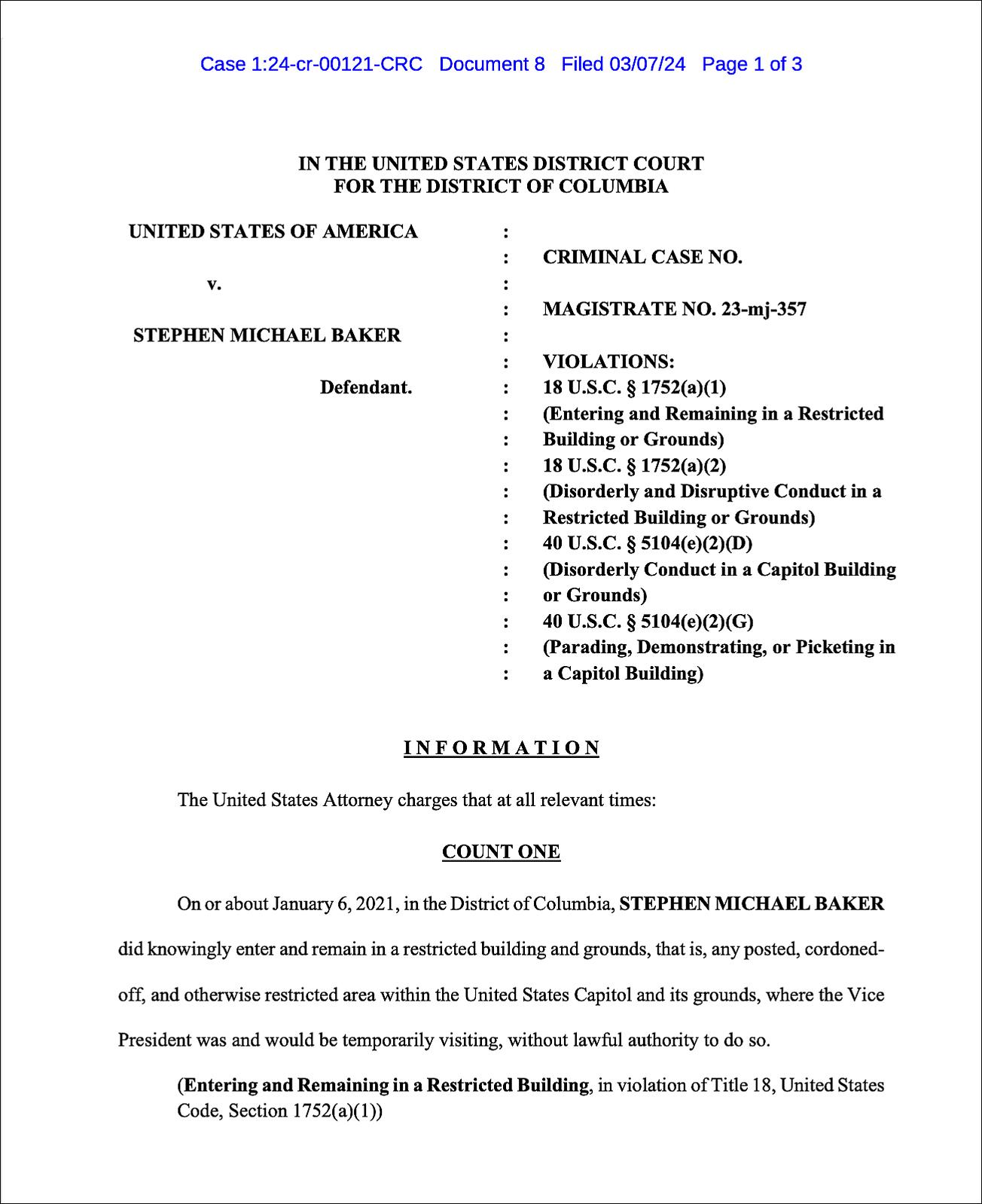
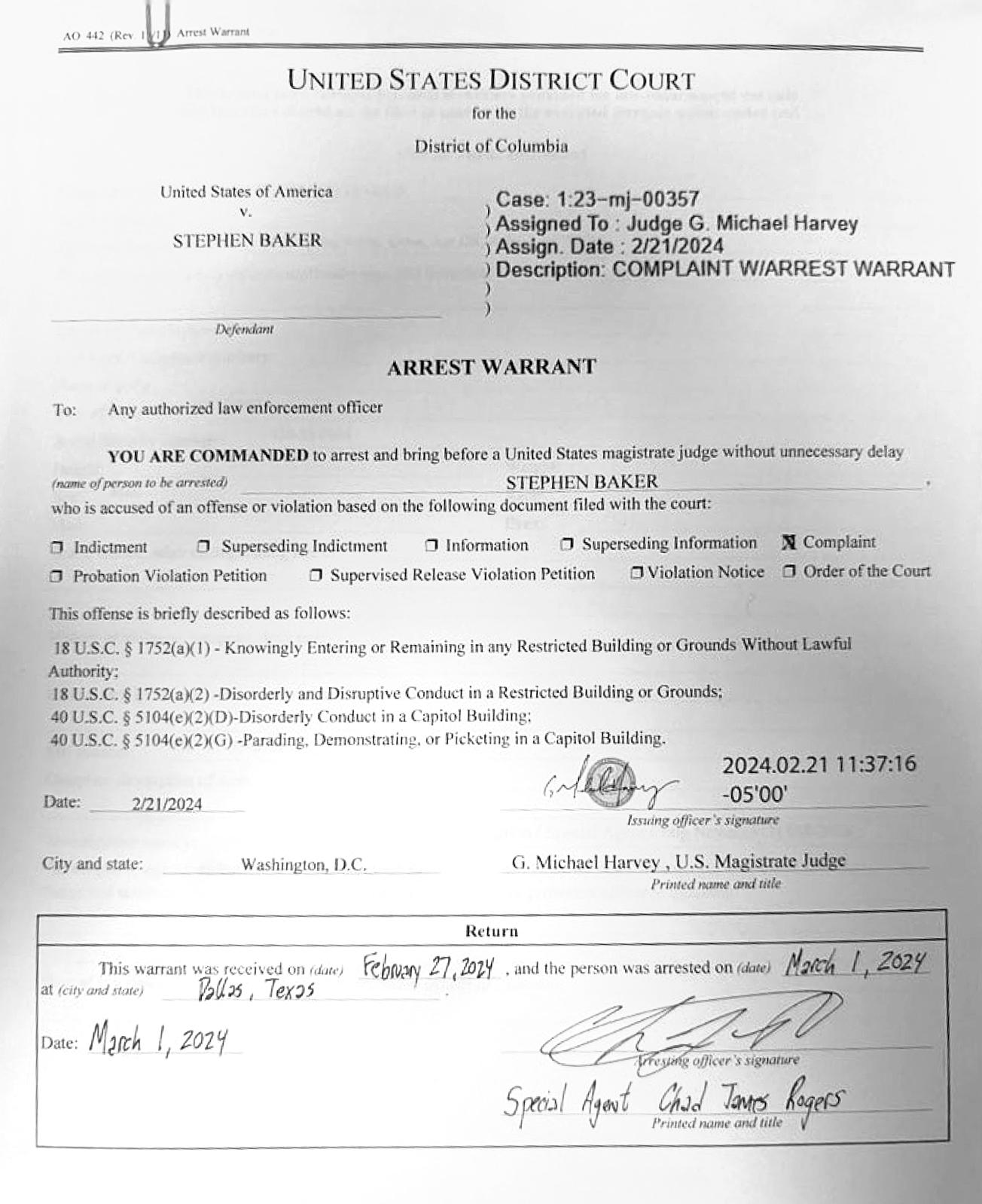
(Left) Documentation shows Steve Baker being charged in a criminal complaint with four misdemeanors related to Jan. 6. (Right) The federal warrant for Mr. Baker showing that he was arrested in Dallas on March 1, 2024. (U.S. District Court/Screenshot via The Epoch Times)
After being processed and released on his own recognizance, Mr. Baker continues to pursue more investigations. He said he has no plans to capitulate in a plea agreement in his criminal case, firm in his belief that the work he did Jan. 6 was that of a journalist.
As for the possible consequences if his case goes the same way as virtually all other Jan. 6 cases, Mr. Baker gets pensive when asked about it.
“If I need for the benefit of my children, for the benefit of my country, if I need to be poured out as a drink offering on the altar of liberty, then so be it,” he said.
“There are only two people on this planet who I give a [expletive] what they think about me and those are the two people who are on this planet because of me,” he said, referring to his grown children, Stormie and Duncan. “Those are the only two people whose opinions I care about.”
